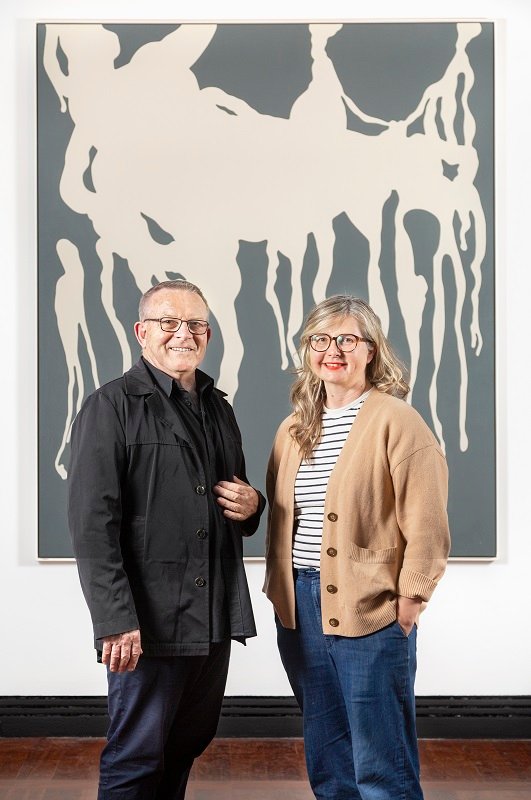It’s a big day for AGSA’s Curator of Prints, Drawings and Photographs Maria Zagala, something like Christmas and a birthday rolled into one.
After six years of careful planning and negotiating Maria is finally unboxing the works of renowned Aotearoa-born, Melbourne-based artist – and friend – Brent Harris (pictured below with Maria).
It’s a day where the theoretical becomes tangible, a day where Maria finally gets her hands on the artwork and can start putting the exhibition – in this case titled Surrender & Catch – together in readiness for the general public.
“It’s a particularly exciting day for me,” she says.
“I am working with the artist, who has flown in from Melbourne, and we’re deciding exactly where his artworks are going to go.”
Of course it’s a lot more complicated than just hanging the works on the wall and hoping they look good. There is, Maria says, a story that must be told.
She has been working with images of Harris’s work (pictured) in the lead-up to Surrender & Catch, virtually arranging them on virtual walls, but things tend to change, she says, when the works emerge from their crates.
“We want to tell the story of Brent’s art over four decades,” Maria says.
“And he’s been very productive over those for decades. So of course there’s a process of selection. And I’ve been lucky enough to have known Brent for about 25 years, visiting him in his studio, and seeing how his work has developed over that time.
“But there are works that we’ve selected to tell his story that were in private collections, and I hadn’t seen them in the flesh.
“So even though we’ve placed them already, theoretically, now we’re in the space hanging it’s often a case of ‘actually, that’s not working’, and ‘oh, actually, that piece, we need to put it somewhere else’ because it has an aura about it and it needs a different position.
“I enjoy that problem solving, which is like a jigsaw in the exhibition space.”
Surrender & Catch, and many other exhibits Maria has curated, feature works held by private collectors, and part of her role is locating those works and writing to the owners to – very kindly – ask if they might consider loaning them to the exhibition.
curated, feature works held by private collectors, and part of her role is locating those works and writing to the owners to – very kindly – ask if they might consider loaning them to the exhibition.
Invariably, she says, they say yes.
“In most cases people are thrilled,” Maria says.
“In Brent’s case, he has actually maintained and formed a friendship with many of his collectors, which is unusual, and they are just really happy to take part.
“I think it’s out of respect for the artists. People tend to say, “if this is important to you, we would love to have the work in the exhibition.
“And, you know, obviously it lifts the value of the work as well.”
Maria says that choosing which works are included in an exhibition can be tricky, especially in cases like Surrender & Catch where the artist has created thousands of works over several decades.
“It’s definitely a process of negotiation,” she says.
“Sometimes there’s agreement, sometimes disagreement. But because Brent and I have such a long working history there’s a great deal of trust between us.
“He knows that I know his practice well, so there’s an enjoyable to and fro.
“It’s really all about direction and storytelling, looking at how much weight you want to put on one work or one series. I’m trying to tell a compelling story and sort of unpack a life and an artistic process over that time.”
Maria says that when, in her early 20s, she first started working as a curator in the National Gallery of Victoria she was star-struck by the work she was handling and artists she was meeting with.
“Up until that point I had studied art, theoretically, and then once I got the job at the NGV I was suddenly catapulted into, you know, meetings with renowned artists and being able to hold Italian Renaissance artworks in my hands,” she says.
“Initially I found that really intimidating and I was sort struck by how blind the people were around me to the awesomeness that must have seemed very everyday to them.
“Within a couple of years, it was just my working world too, and it became second nature to me too. However, I think I’ve always manage to maintain a sense of wonder.”
Maria says her time at the Art Gallery of South Australia has had many highlights, but she particularly enjoyed working on 2023’s Andy Warhol and Photography: A Social Media and 2020’s Restless Dance Theatre: Seeing Through Darkness which saw dancers responding to artworks within the gallery through live performance.
She says that even after traversing the North Gallery thousands of times she still finds new inspiration in its works and exhibitions, and she still has great hope for the future of art in an increasingly digital world.
“On one hand art is superfluous because we don’t need it to survive,” Maria says.
“But then we do turn to it in order to make sense of our lives.
“People still flock to the gallery to have an encounter with objects. People haven’t given up on that. There is something about the material object that absolutely pulls people in, something that the digital world still can’t provide.”
For anyone hoping to pursue curating as a career, Maria says the first step is to study art history and curatorial and museum studies at university.
“Then it’s a case of getting as much experience as you can with original works of art. That could be in a council gallery, or they could apply to a state gallery for placement. But there’s no kind of substitute for actual experience with original works of art.”
Surrender & Catch, Art Gallery of South Australia, July 6-20. Entry is free.

